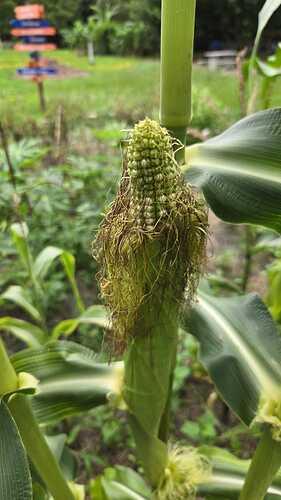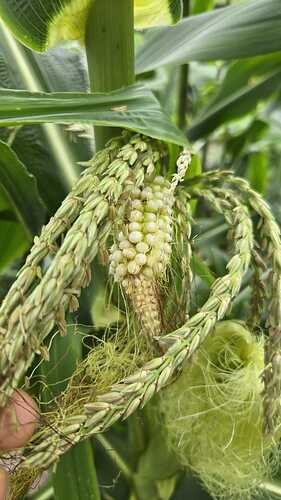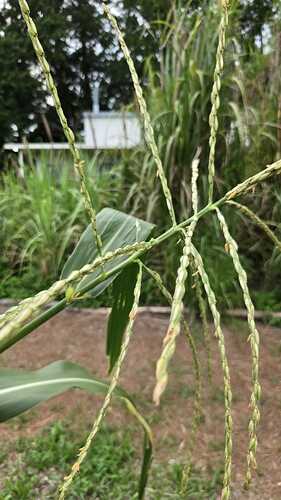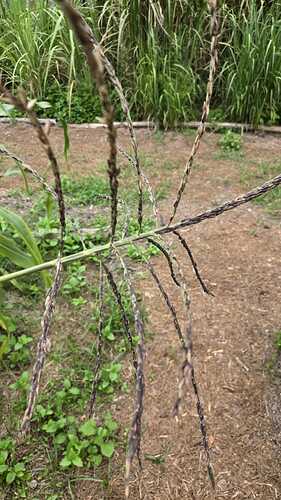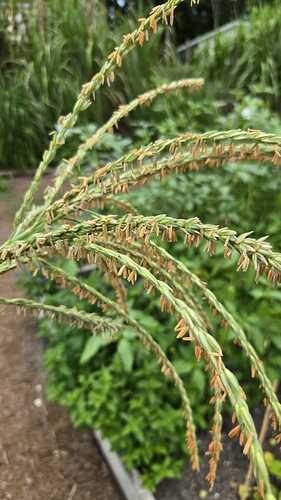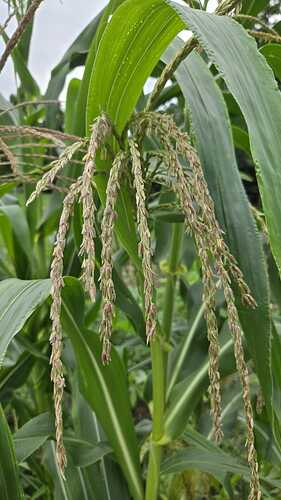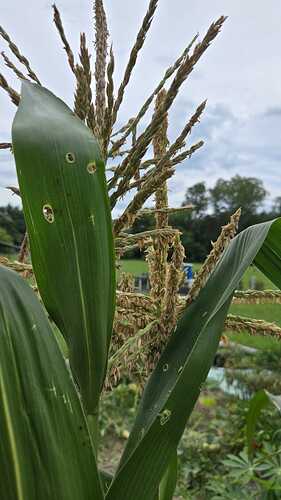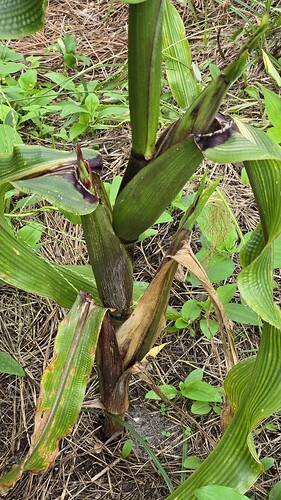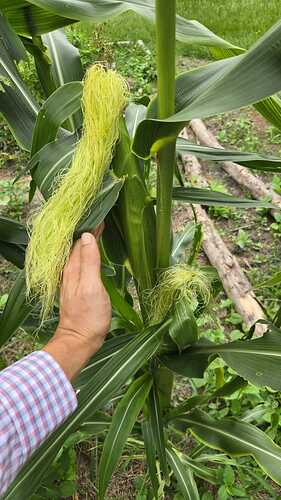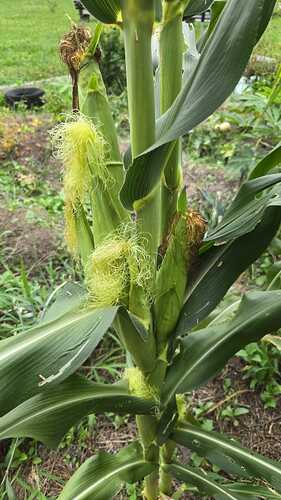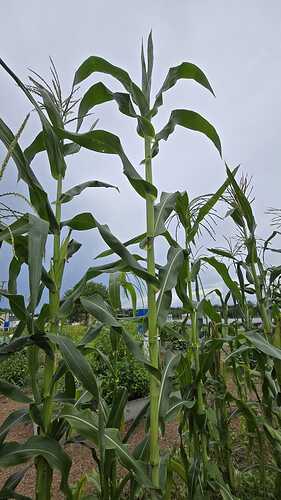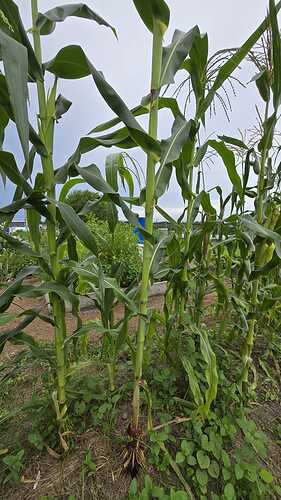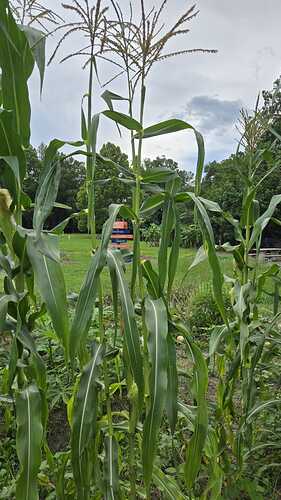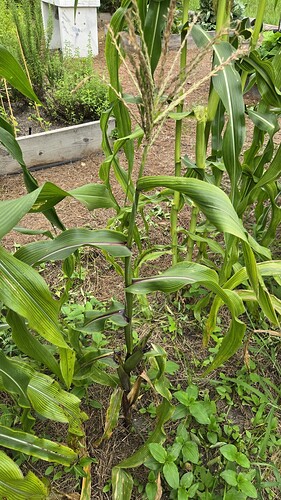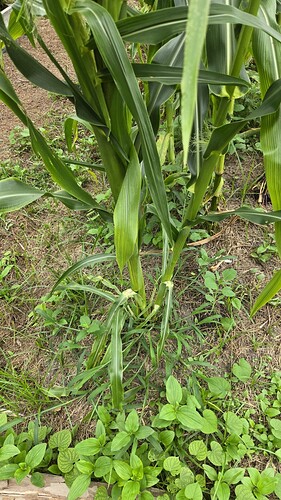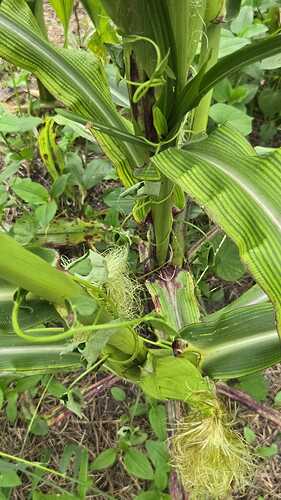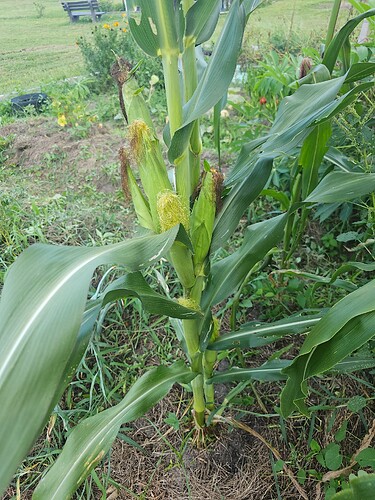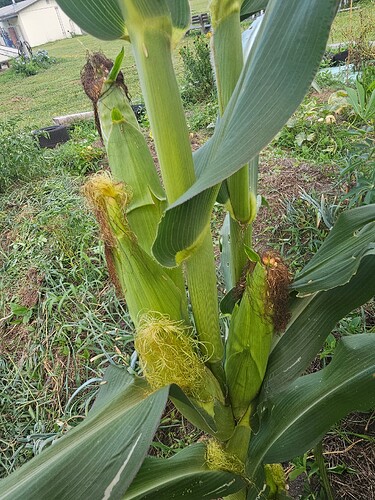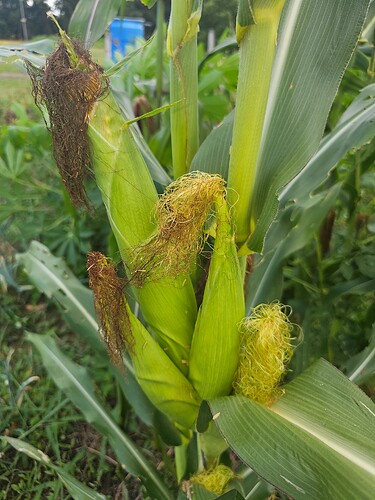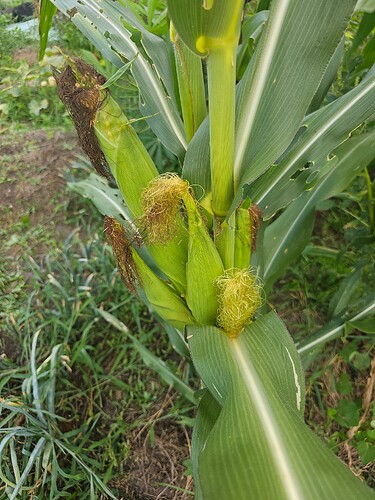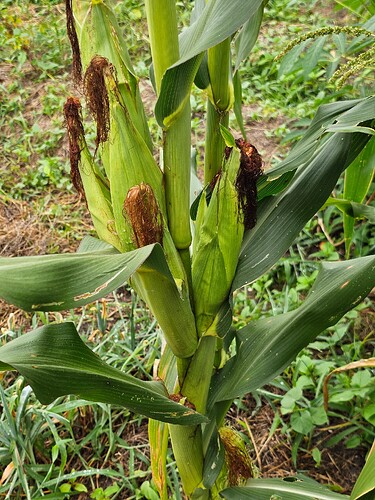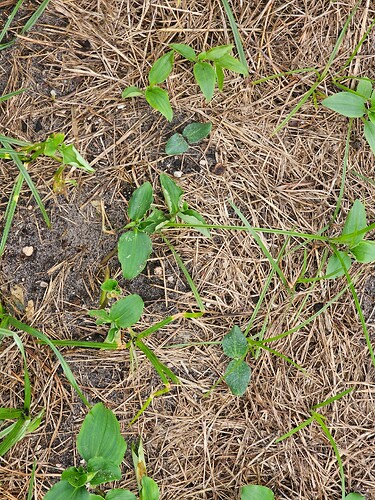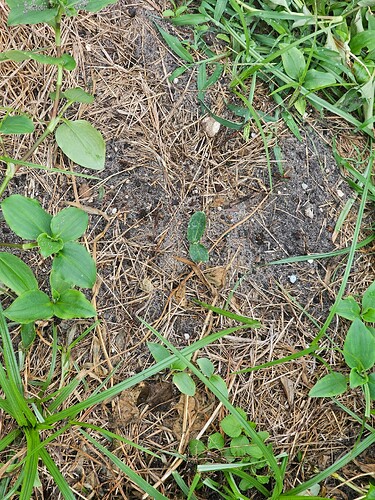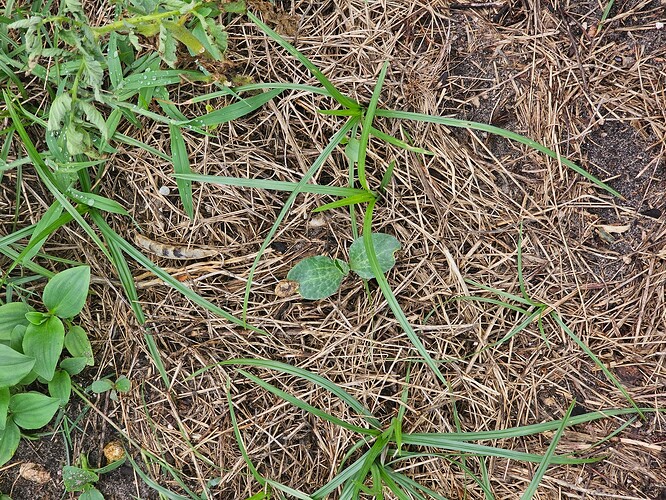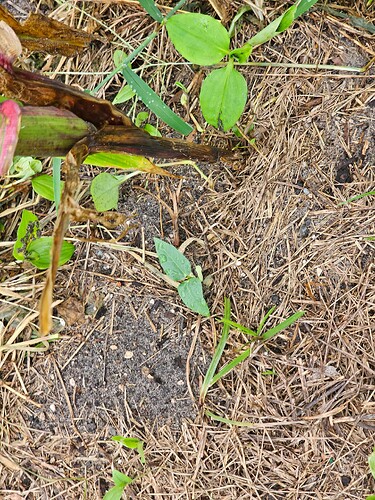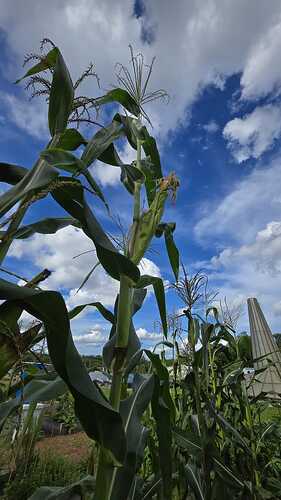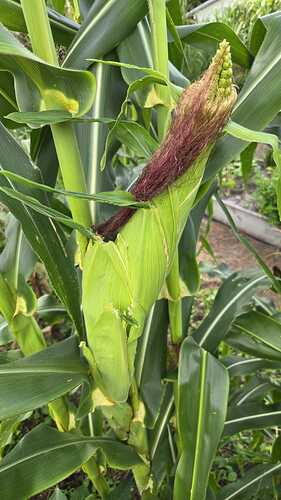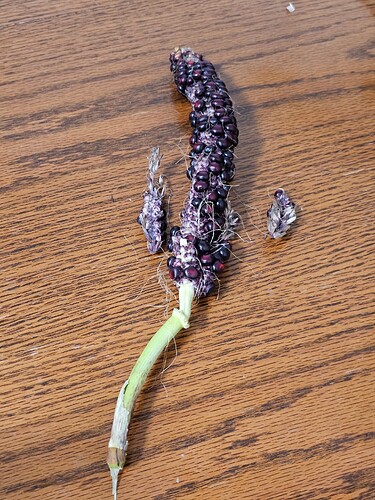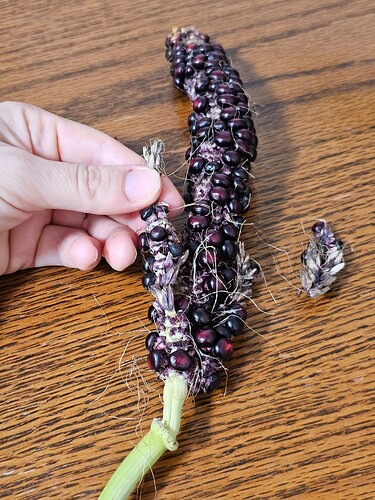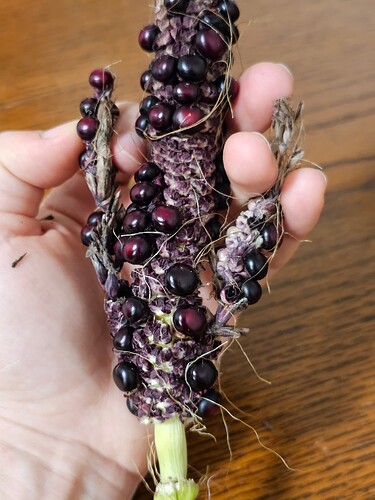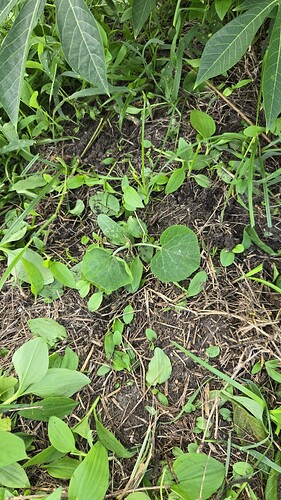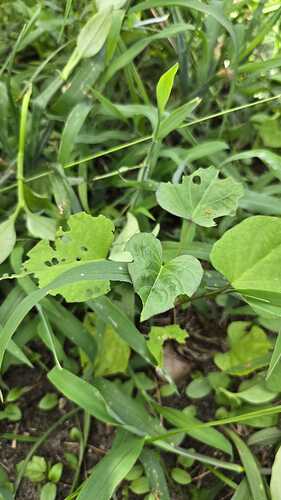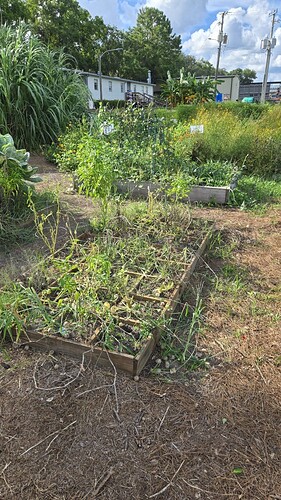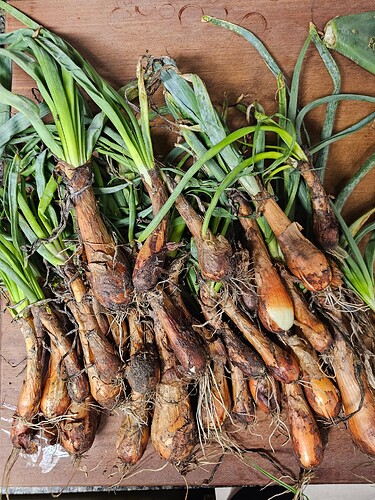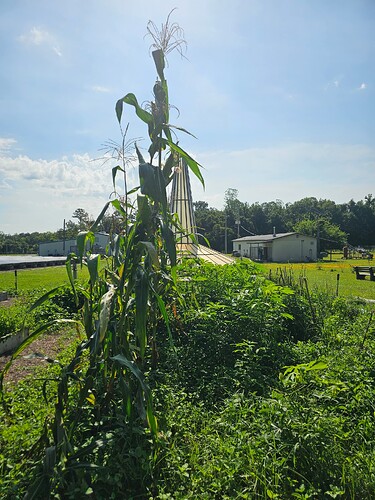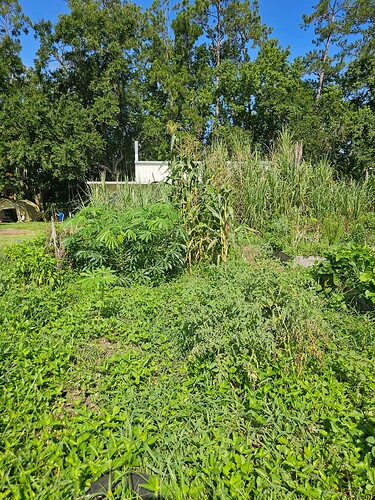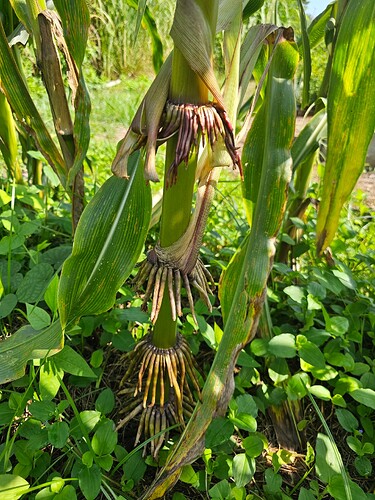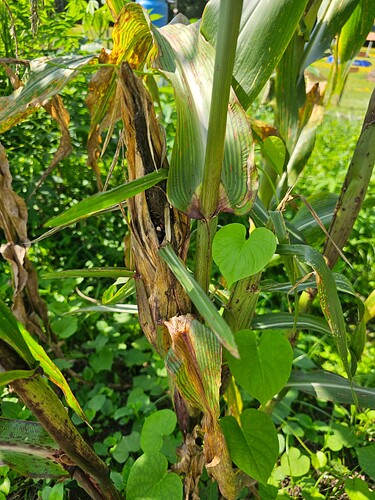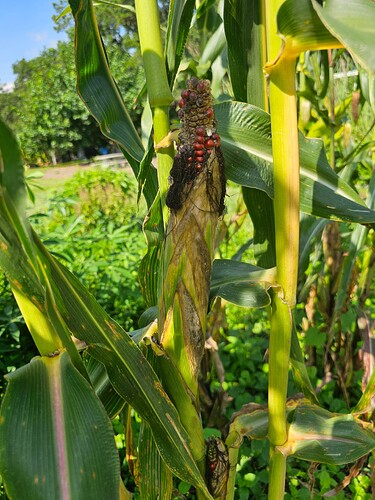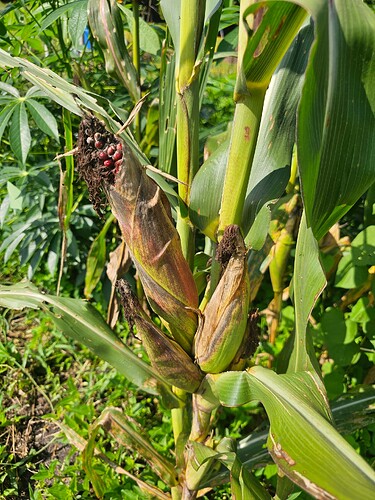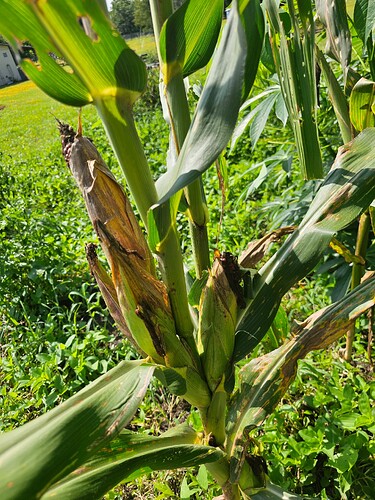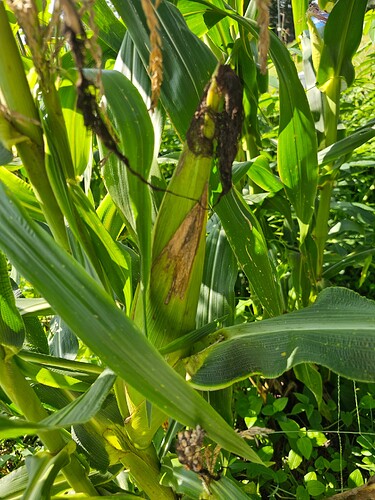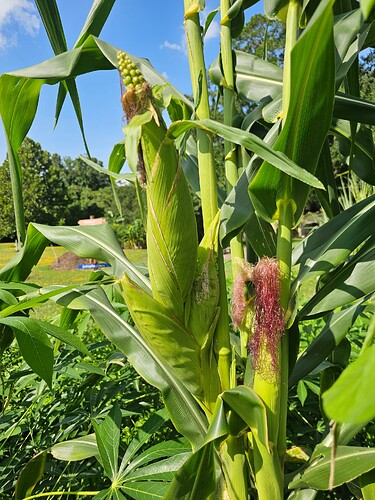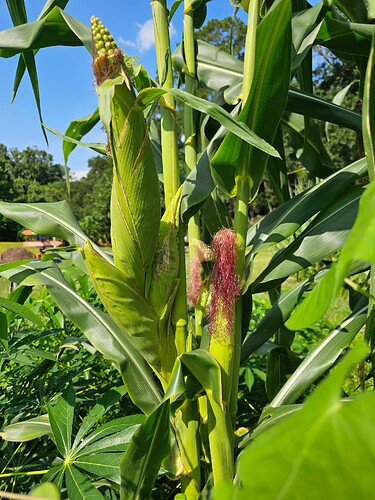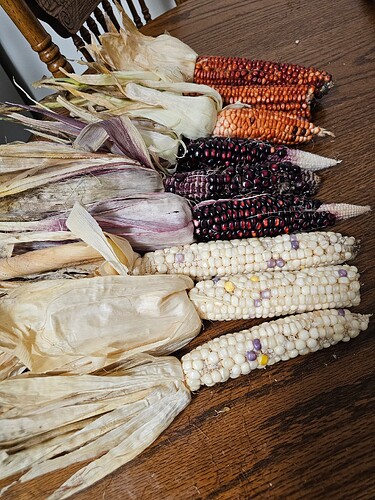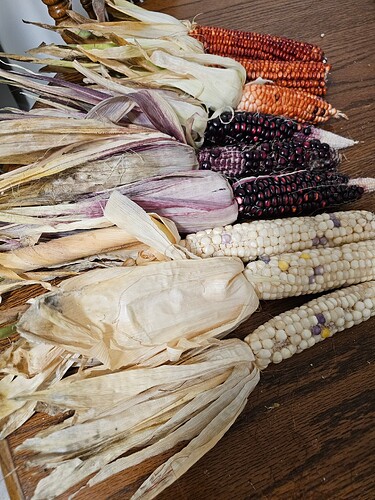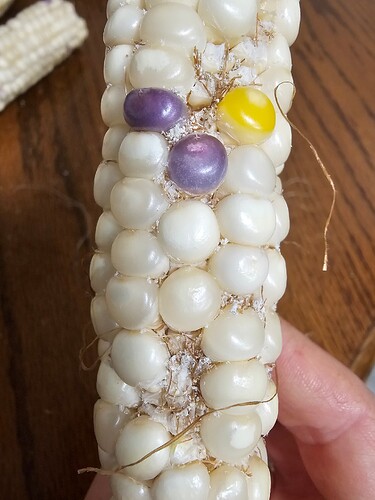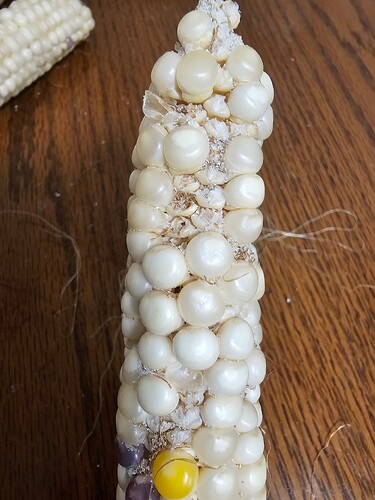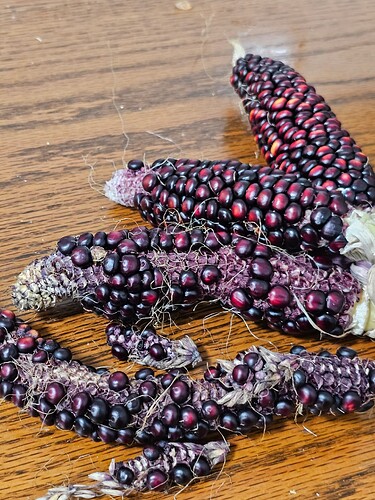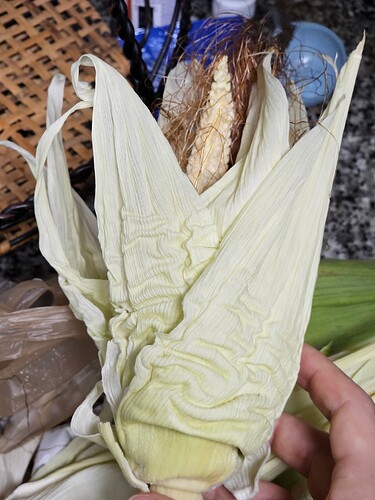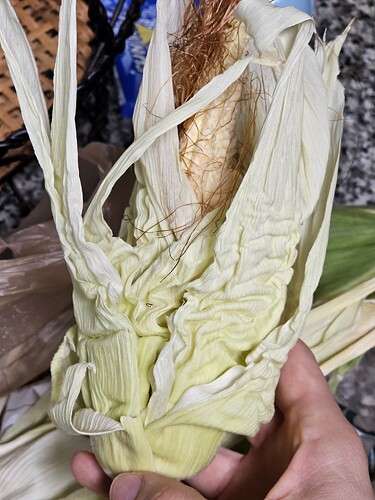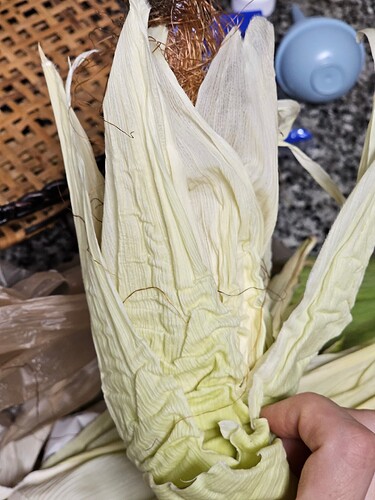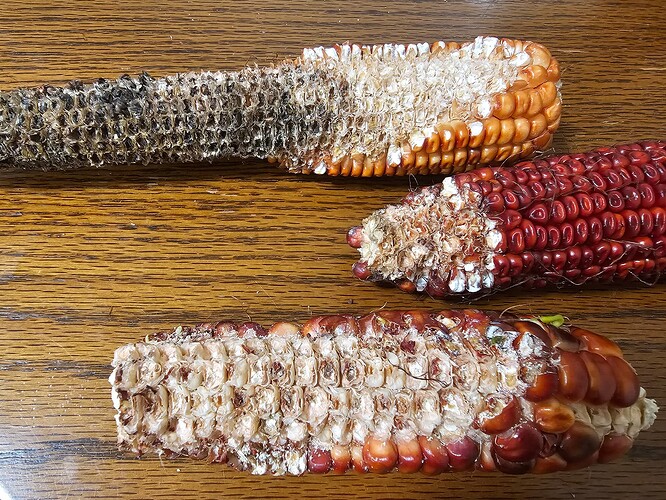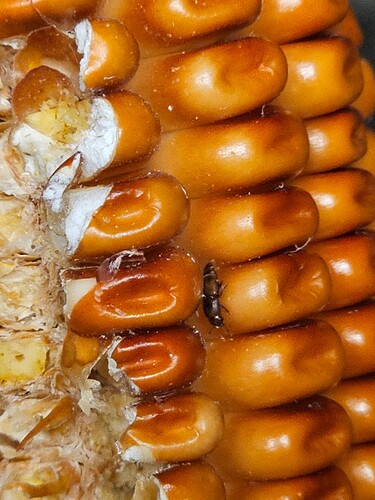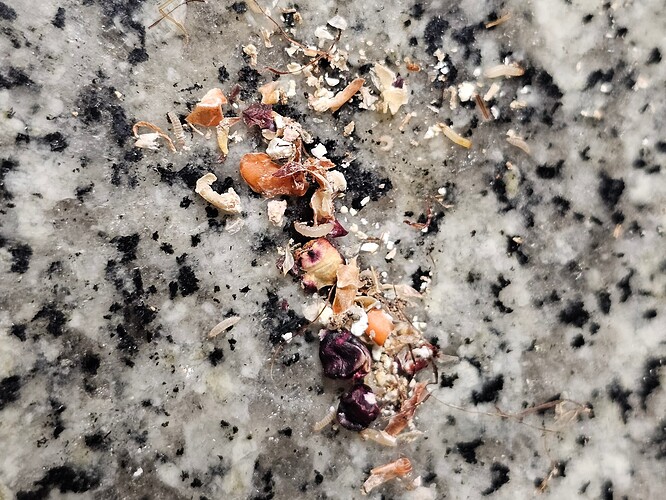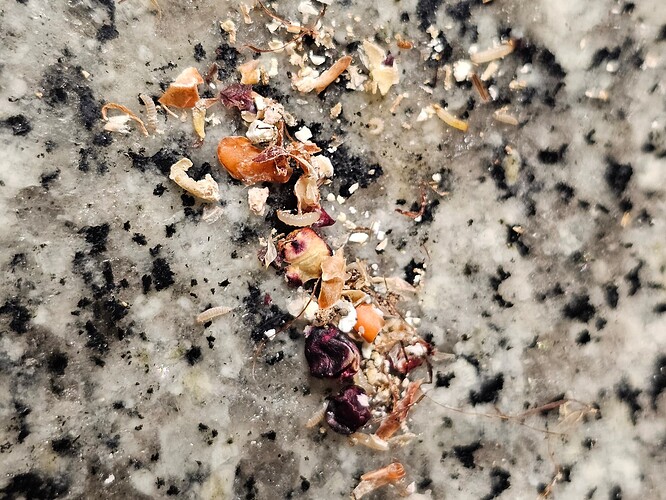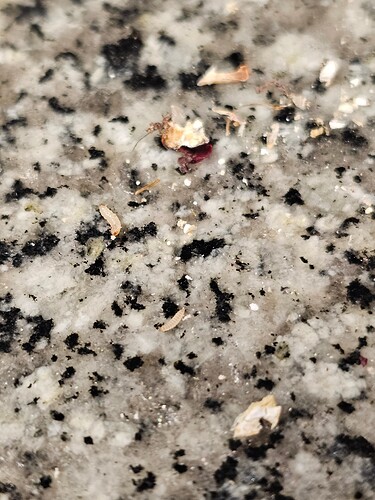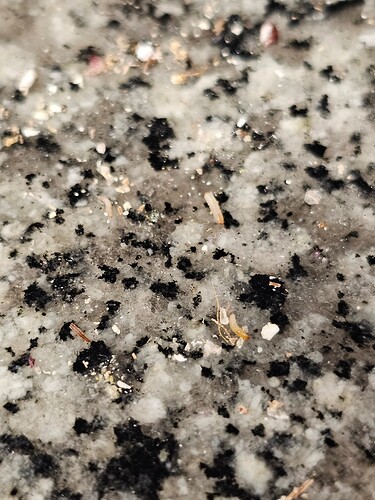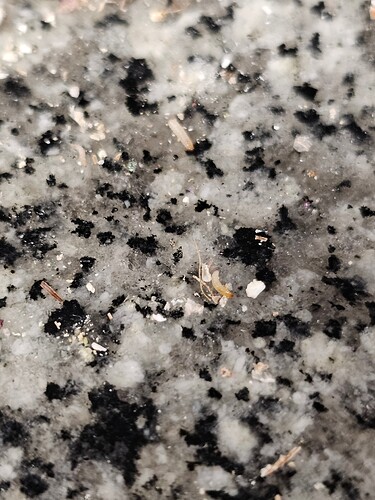06/19/2025:
Dani made a surprise visit to the garden after work to see the progress of our corn plants.
The imperfect corn cobs, it looks like there is two that have emerge from their cobs.
Photos of the corn tassels, one of the corn tassels looks purple in color, and the others are green.
It looks like some of the plants have many corn cobs on each plant. More than the usual 2-3. The purple corn tassels looks like it matches and goes with the plant with the purple cobs.
Photos of various corn plants.
Some sort of viney weed is growing up the corn. We are going to de-weed the garden, and plant Puerto Rican black beans into the corn area. We also want to plant the rooted sweet potatoes slips, and extra poblano/Ancho peppers and Mirasol/guajillo peppers into various parts of the garden in preparation of the summer garden.
2 Likes
6/22/25:
This visit was short, it was too hot and humid for our boys. We were able to pull some weeds amongst the two rows and checked out the progress of our projects.
I didn’t see this during last visit, but we have a nitrogen fixing corn plant with 5+ corn cobs.
They all look to be different sizes, and are still filling out. We hope that this particular plant survives to produce seed. 5+ is the most cobs of corn on a single plant that we ever produced.
The Seminole Pumpkin plant has died. It looked like it was doing well too during our last visit.
We planted a lot of Puerto Rican black beans under our corn plants, in hopes that they can climb up the giant corn stalks and planted lots of Arajuna f2 pumpkin seeds everywhere there was open space.
Note to self: We haven’t watered the garden in a long time. The last time that we had watered anything was probably the end of April or start of May, it has been raining consistently, a couple or few days every week.
5 Likes
06/29/25:
Photo of the progress of the garden from the front, very weedy. Every time we visit it is rainy and muggy, with lots of mosquitoes. It got so bad that I forgot to take a photo of the garden from the back view.
Our interesting nitrogen fixing flour corn plant specimen. It looks like there are actually 7 coins of corn on this one plant. One cob looks full sized while the others are smaller, and not regular sized.
Some of our pumpkin plants have sprouted, I hope that these can survive and do better than that lone Seminole pumpkin seedling that died last visit.
We soaked 50+ seeds of what could be “Arajuna” f2 pumpkin seeds and planted them in all of the open sunny spots of our two rows of garden space. It is going to be rainy from this point on until the 8th of July.
What looks like a Puerto Rican black bean seedling coming up.
A photo of a pest frequenting the tomatillo plants, there are so many of them out here. They look like leptoglossus sp. And might be the ones that are leaving indentations all over the Tomatillo fruits.
Before we left Dani planted out a lot of our rooted “Tainung 64” sweet potato slips into the garden.
Next visit we will hopefully do we get everything and take more photos of the progress in the garden.
1 Like
08/07/25:
We weren’t able to visit the garden over the weekend. It was very rainy and our eldest baby boy was sick. My husband instead visited the garden in my place, and took these pictures.
The corn is looking very healthy. It was noticeable that the purple corns were not as healthy as the green ones.
Dani picked a corn cob from one of the weaker looking purple corn plants. This particular cob had two underdeveloped side cobs growing from the main corn cob. Is this a desired trait? Are these suckers? We are going to allow this cob to dry further inside our apartment.
Pumpkin seedlings were looking in need of some tlc. Dani helped them out by watering them.
Something is eating our the leaves of our rooted sweet potato slips. We were not able to see the culprit during this visit.
The raised bed with the tomatillo plants have all been cut down because of it being late into this growing season. Also because a lot of the fruits falling and rotting from the plants, and attracting a lot of pests.
Dani was also able to weed here and there, and pulled up the harvest of yellow onions because it was difficult to deweed all of the grass in the area without pulling up onions as well.
Next visit to the garden we are going to replant the yellow onion bulbs and hope that they grow a larger size.
1 Like
I think I found an article about the phenomenon of a corn plant producing a cluster of many cobs on a corn plant, also known as "bouquet ears:
This looks similar to what is happening to some of our corn plants. Does anyone know if this is what is happening to our nitrogen fixing corn plants? Any insight is appreciated.
1 Like
07/13/25:
We visited the garden at a different time, the morning instead of the evening. It was still hot, humid and we were swarmed by mosquitoes.
These are updated photos of the garden going ons.
There are so many weeds. I was able to pull up the weeds from the first row, were the row of corn is at all the way to the other end with the tomatoes. But didn’t take any photos of it. Hopefully, next time we will weed some more.
This corn stalk had the most sets of nitrogen fixing aerial roots.
We picked some cobs that looked like they were ready for harvesting. As we didn’t want the bugs, or the cobs to get moldy. We would rather them dry to instead dry inside our apartment. I am considering these to be early maturing.
There are many cops still out there that are still green in color. We are waiting for the color to change before we pick them. Some of the taller corn plants put out their fruit late, and are still filling out.
Our early maturing ears of corn, we have braided these and put them aside to dry. So far there are three colors that we noticed that our corn comes in three main colors. Purple, this orangey color and white.
This cob of corn has a lot of frass from some sort of critter?
I didn’t see any pumpkins sprouts that survived. We had a handful of Puerto Rican black bean (vigna sp.) sprouts that have survived and hopefully will grow up our nitrogen fixing corn.
Next time I will plant the pumpkin seeds and Puerto Rican black beans earlier for our Three sisters Garden. This year it was partly unsuccessful, because I planted the Puerto Rican black beans and pumpkin seeds too late.
Dark purple colored corn cobs? Is that how you describe this color? Dani noticed that the stalks of this type are not as strong as the other types present in this line. I love the color. Would make nicely colored corn tortillas.
White colored corn cobs, they have one or two yellow, and a few lavender purple colored kernals on each cob of this type.
TThe white corn cob all the way in the back is warped looking. It’s husk also look very similar, very whirled and warped. We do not know what that’s all about.
Rusty dented orange-red corn cobs, the dominant phenotype in this line. Very long, large cobs of corn. We have the most of this type so far.
Irregular round rusty orange-red corn cobs, rows of this type is irregular or non-straight. I checked online, and it says that this might be a “sign of pollination issues or environmental stress during kernel development.”
We also found some pests on the corn cobs as we shucked them.
Some weevil? Is that what this critter is? It was found crawling in between the the kernals.
Some sort of caterpillars that were eating the corn kernals. I put them inside a jar with the affected corn kernals to see what kind of moth that they turn out to be. I want to identify the moth.
At the end, we set aside all of the crooked and mini tiller-sucker corn cobs that are not full size for making masa, and are drying the rest of the cobs for a seed increase.
1 Like
